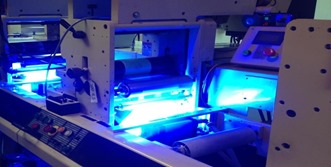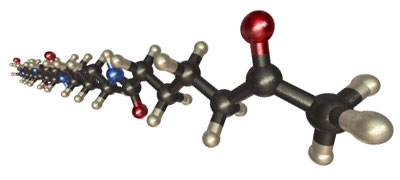Guest Blog Post by Dan Lamone
 Now that we’ve selected our bulb type and coverage area, we are now concerned with the amount of UV exposure to fully polymerize our resin. Our two key variables are energy density and power density.
Now that we’ve selected our bulb type and coverage area, we are now concerned with the amount of UV exposure to fully polymerize our resin. Our two key variables are energy density and power density.
Photo Courtesy: Air Motion Systems, Inc.
Most UV processes will evaluate energy density as energy / surface area, often in joules or millijoules per square centimeter (J/cm2 or mJ/cm2). The energy density value roughly translates to the total amount of energy required to activate all photoinitiators within the UV curable resin to fully polymerize the resin. The total energy required to fully cure a UV curable resin is a function of several variables and changes with cure thickness, photoinitiator concentration, amount of material to react, specific chemical functionality, etc. Instead of calculating photon energies for each process, a process spec or technical data sheet should specify the UV source radiation with the energy density requirement such as 500mJ/ cm2 using a 365nm UV LED source.
Power density comes into play when a process engineer works to determine the rate at which UV radiation is supplied to the UV curable resin. The rate at which UV radiation is supplied to the UV curable resin correlates with the rate at which photoinitiators absorb UV radiation to initiate the monomer polymerization. In colloquial use, peak irradiance is often interchangeable with power density with name using units of power / surface area, often watts or milliwatts per square centimeter (W/cm2 or mW/cm2). More formally defined, peak irradiance is the highest power density applied to the UV curable resin while power density is generally considered the average irradiance applied to the UV curable resin – this difference becomes important when analyzing the efficacy of your UV source.
Relating power density and energy density requires a short trip down memory lane to your last physics course. Whether or not this brings back found memories or not, recall that a watt is a composite unit of joules per second (J/s) and multiplying watts by seconds yields joules. This physics interlude relates to our discussion of UV exposure in the following equations:
The total exposure time at a specific irradiance combine to give the total amount of energy supplied to the UV curable resin This implies that the power density and exposure time are not independent. For example, if a UV curable resin has an energy density requirement of 500mJ/ cm2 using a 365nm UV LED source, we could meet our energy requirement under several different exposure periods: a 50 second exposure with a 10 mW/cm2 power density, a 5 second exposure with a 100 mW/cm2 power density, 0.1 second exposure with a 5000 mW/cm2 power density, or any other time-power combination whose product is 500mJ/ cm2. As the power density is related to the total energy density, a complicated function of several variables, you might intuitively expect that the power density cannot be chosen at random. And you’d be right.
Many UV curable resin suppliers will give you a range of irradiance values that are appropriate but in many cases the irradiance will need to be experimentally determined using your specific process. The guiding principle for UV polymerization is to supply the total energy requirement with the minimum irradiance possible. This implies a give and take relationship between production throughput requirements and the resin chemistry itself. Low levels of irradiance imply longer exposure times which can cause potential production bottlenecks. High levels of irradiance will significantly shorten exposure times but, depending on your application, can damage or cause abnormalities in your coating or resin properties. Generally, lower irradiances are better but applications exist where a “run and gun” approach using high power densities is entirely appropriate such as UV curable coatings for high throughput flexographic printing applications, an example of which is shown in the photo above.
Next week’s blog post will focus on measuring UV exposure and several best practices for UV processes.


Leave a Reply